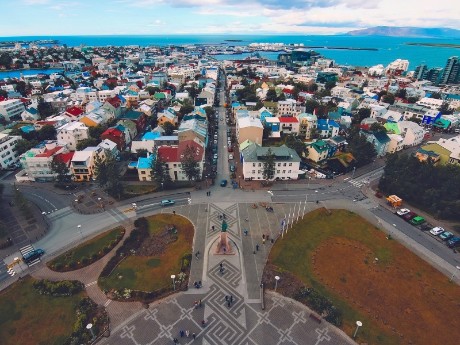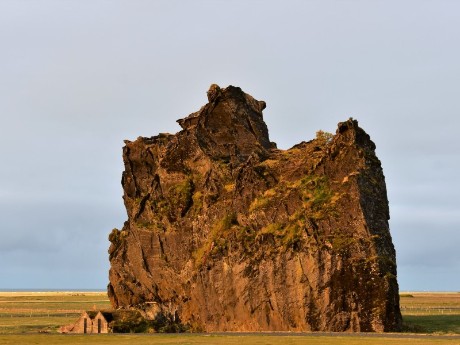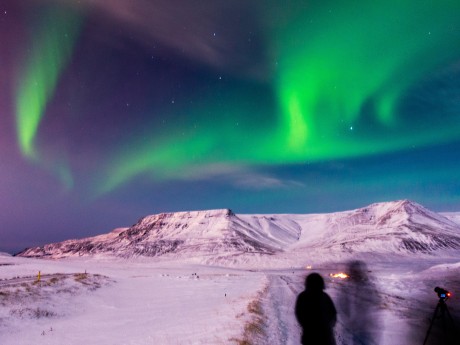Iceland: Reykjavík & Vík
Don’t miss your chance to experience the magic of Iceland. From Reykjavik, visit natural wonders such as the Blue Lagoon and the Golden Circle. Be amazed at the Black Sand Beaches when in Vik. Renting a car will allow you the freedom to take numerous day trips and travel between destinations with ease while marvelling at the sites along the journey. Immerse yourself in the vibrant culture of the capital, Reykjavik and explore the museums and art galleries around.
Read more
Don’t miss your chance to experience the magic of Iceland. From Reykjavik, visit natural wonders such as the Blue Lagoon and the Golden Circle. Be amazed at the Black Sand Beaches when in Vik. Renting a car will allow you the freedom to take numerous day trips and travel between destinations with ease while marvelling at the sites along the journey. Immerse yourself in the vibrant culture of the capital, Reykjavik and explore the museums and art galleries around. Have a panoramic view of the coastline at Dyrhólaey Arch or visit the magnificent Skogafoss waterfalls near Vik. Create unforgettable memories in this land of beauty and adventure. Waterviews strives to offer accommodation options within walking distance of water and/or in an area of touristic interest. Our prices include taxes (but excludes local tourist taxes). Customize your trip to your personal preferences with optional activities (hit the “Add Activities’’) or change hotels, etc. Contact us for customization at no extra cost at: Service@waterviewstravel.com
Destinations
- Reykjavík
- Vík í Mýrdal
Itinerary
Reykjavík

The world’s most northerly capital and home to more than half of Iceland’s population, Reykjavik is a creative and colourful city. Despite its small size in comparison to other capitals, Reykjavik boasts a thriving cultural scene, with a plethora of art galleries, museums and shops featuring modern Icelandic design. Trendy cafes merge day into night time when the city comes alive with excellent restaurants and bars, as well as an epic music scene. Make time to explore before taking a day trip to the famous Blue Lagoon.
Read more
The world’s most northerly capital and home to more than half of Iceland’s population, Reykjavik is a creative and colourful city. Despite its small size in comparison to other capitals, Reykjavik boasts a thriving cultural scene, with a plethora of art galleries, museums and shops featuring modern Icelandic design. Trendy cafes merge day into night time when the city comes alive with excellent restaurants and bars, as well as an epic music scene. Make time to explore before taking a day trip to the famous Blue Lagoon.
Additional Information
History
When it started to develop as a town in the 18th century, Reykjavík had already been inhabited for almost a thousand years. Legend has it that the first permanent settler in Iceland was a Norwegian named Ingólfur Arnarson. He is said to have thrown his seat pillars into the sea en route to Iceland, and decided to settle wherever the pillars were found. The pillars washed up in Reykjavík, and so that was where he set up his farm.
Although the story of Ingólfur Arnarson is not widely believed to be true by modern historians, it's clear that Reykjavík was one of the very first settlements in Iceland. Archaeological remains confirm that people were living there around the year 871, and for the first few centuries of Icelandic settlement, Reykjavík was a large manor farm. Its fortunes steadily waned as other centres of power increased in importance. By the 18th century, the farm of Reykjavík was owned by the king of Denmark (under whose domain Iceland fell at the time). In 1752, the estate was donated to a firm, Innréttingarnar, led by Icelandic politician Skúli Magnússon. Innréttingarnar were meant to become an important industrial exporter and a source of development in Iceland, and their main base was in what is now the heart of Reykjavík. Although the company didn't achieve all its high ideals, it did lay the foundations of Reykjavík as it is today. In 1786, Reykjavík got a trading charter and it soon started to grow in importance.
In 1801, Reykjavík went from being the largest town in the country to its capital. That year a new supreme court, Landsyfirréttur, was set up in the city after the abolition of Alþingi (which no longer had any legislative functions). The same year the office of the Bishop of Iceland was founded in Reykjavík, merging the bishoprics of Hólar and Skálholt. In 1845, Alþingi was re-founded as an advisory council to the king on the affairs of Iceland, located in Reykjavík and in 1874 it regained legislative powers. As the sovereignty of the country grew, so too did Reykjavík, which by the beginning of the 20th century had been transformed from a small trading and fishing village to a fully fledged capital.
The Second World War was a boom era in Reykjavík. The city wasn't directly affected by the many horrors of the war, but the occupation of Iceland by first the UK and later the US provided increased employment opportunities and inflows of cash that enabled the rapid expansion and modernisation of the Icelandic fishing fleet. Reykjavík was a leader in this development and it grew very rapidly in the years following the war. New suburbs were built and the city started to reach across municipal limits, subsuming various surrounding communities. The city continued expanding until the financial collapse of 2008.
Because it is young, and in particular it expanded rapidly in the late 20th century, Reykjavík is very different from the other Nordic capitals. It lacks their grand buildings and the picturesque old quarters. Instead it has come to resemble American cities with their sprawling suburbs and big motorways, as was recommended by the urban planners of the post-World War II era. Nevertheless Reykjavík has a charm of its own, quite unique, shaped by the dualistic nature of this place which still doesn't seem to have made up its mind on whether it's a small town or a big city.
Climate
The weather in Reykjavík is notoriously unpredictable. One minute the sun may be shining on a nice summers day, the next it may change into a windy, rainy autumn. Temperatures in Reykjavík are quite bland: They don't go very high in the summer, nor do they go much below zero during winter. It follows that the differences between seasons are relatively small compared to what people experience on either side of the Atlantic.
January is the coldest month and usually has some snow, while there is frequently no snow on the ground during Christmas in December. Summer is without a doubt the favorite season of most Reykjavík inhabitants. Many of them seem to imagine their city is slightly warmer than it really is and it takes little to get them to start wearing shorts and t-shirts, or to go sunbathing in parks. Don't think too much about how silly it may seem, just join them in enjoying the season!
Wind is the main problem with the Reykjavík weather. The city is quite open to the seas, and the winds can be strong and chilling to the bone.
Literature
The Fish Can Sing (Halldór Laxness, 1957). A story of a young boy growing up on a farm on the outskirts of Reykjavík in the early 20th century, during a period of rapid change in Iceland. Like many of the stories by Nobel laureate Halldór Laxness, The Fish Can Sing (Brekkukotsannáll, "The Annal of Brekkukot", in Icelandic) is partly based on real people and places, although names have been changed. 101 Reykjavik (Hallgrímur Helgason, 1996). The quintessential book about downtown Reykjavík, capturing its spirit in a way no other book has. The main character never leaves postcode 101 if he doesn't need to, and spends his time either in bars and clubs or at home doing nothing. He has since become seen by many (who don't live in central Reykjavík themselves) as the model for the "101-type". Jar City (Arnaldur Indriðason, 2000). A crime novel about the detective Erlendur, with the Reykjavík criminal police department. Portrays the grittier sides of the city, although perhaps slightly exaggerated for the sake of writing a good story. The book has also been translated as Tainted Blood, but the original Icelandic title (Mýrin, "the swamp") refers to the Norðurmýri neighbourhood, by the city centre. Arnaldur has written 10 further books about the detective, most of them happening in or around Reykjavík.
Tourist information
"Visit Reykjavik" website (the physical tourism office closed)
© Sourced from Wikivoyage
Vík í Mýrdal

The small seafront village of Vik i Myrdal is a quaint and remote community which has become a popular destination for those visiting the beautiful South of Iceland. Set on a sandy beach and dominated by the Mýrdalsjökull glacier which covers the Katla volcano, the area is home to some of the most raw and untouched nature in the country. To the west of Vik is the black sand beach of Reynisfjara and its nearby cliffs full of puffins and seabirds, and during summer the village comes alive as its many visitors are welcomed by friendly locals.
Read more
The small seafront village of Vik i Myrdal is a quaint and remote community which has become a popular destination for those visiting the beautiful South of Iceland. Set on a sandy beach and dominated by the Mýrdalsjökull glacier which covers the Katla volcano, the area is home to some of the most raw and untouched nature in the country. To the west of Vik is the black sand beach of Reynisfjara and its nearby cliffs full of puffins and seabirds, and during summer the village comes alive as its many visitors are welcomed by friendly locals.
Additional Information
Vík is a very small village, with about 300 inhabitants. Its importance comes largely from the fact that it's about half way along the south coast, the largest settlement in the surrounding area and it's one of the few villages actually on the sandy beach that makes up most of the south coast of Iceland. The area is dominated by Mýrdalsjökull, the glacier which is home to Katla, one of Iceland's fiercest volcanoes. The village and the surrounding countryside are in constant danger of floods that might result from a potential volcanic eruption, which has been expected for many years now. On the other side of the village lies the Atlantic ocean which is treacherous in these parts, waves can be big and small boats easily get swallowed up if the crews are not experienced enough. While there is no reason to worry about the volcano if you're a tourist, you should be very careful going into the sea - there have been cases of tourists drowning when caught by waves on the beach near Vík.
© Sourced from Wikivoyage





